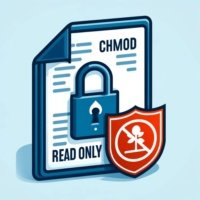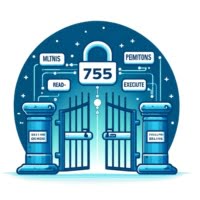Linux
23 May 2024
Chmod Read-Only Permissions | A Unix/Linux User’s Guide

Maintaining data integrity and security on Unix/Linux servers at IOFLOOD often involves making files read-only using chmod. The chmod command, when configured to restrict write permissions, prevents unauthorized modifications to critical files. In this guide, we’ll explore the process of making a file read-only using chmod, to assist our bare metal cloud customers and fellow
23 May 2024
Using Chmod Executable | A Unix File Permissions Tutorial

In Unix/Linux environments at IOFLOOD, making a file executable using chmod is a fundamental task for running scripts and programs. In this article, we’ll explore the steps and commands required to make a file executable using chmod, to assist our dedicated cloud hosting customers and fellow developers in effectively managing file permissions. This guide will
23 May 2024
Using Chmod for Directory Permissions | A Linux Tutorial
While managing directory permissions on Linux servers at IOFLOOD, we commonly utilize the chmod command to control access to the files and subdirectories within. In this guide, we’ll delve into the specifics of using chmod on a directory in Linux, providing practical examples and detailed explanations, in order to provide best practices to our dedicated
23 May 2024
chmod | How to Change Permissions of All Files in Directory

Knowing how to chmod all files in a directory is essential when it comes to managing file permissions on IOFLOOD servers. To assist our cloud server hosting customers and fellow developers we present today’s article. For your guidance, we have provided practical examples and detailed explanations on how to managing file permissions across directories in
23 May 2024
‘chmod 777’ Usage Guide | Unix File Permissions Explained

On Unix servers at IOFLOOD, setting appropriate file permissions is key to balancing functionality and security. The chmod 777 command provides the most permissive access, allowing all users to read, write, and execute the file. As we want our dedicated hosting customers to be aware of the advantages and pitfalls of this command, we have
23 May 2024
chmod 775 Command | Linux Usage, Tips, and Examples

During the management of file permissions on IOFLOOD Linux servers, the chmod 775 command is a key tool for setting appropriate access levels. The chmod 775 command grants read, write, and execute permissions to the file owner and the group, while allowing read and execute permissions for others. Today’s article will delve into the specifics
23 May 2024
What is chmod 755? | Linux File Permissions Guide

When configuring file permissions on servers at IOFLOOD, the chmod 755 command is a useful tool for ensuring the right balance between accessibility and security. The chmod 755 command allows the file owner to read, write, and execute the file, while granting read and execute permissions to group members and other users. In this guide,
23 May 2024
Mastering ‘Chmod 700’ | Command Guide for Linux/Unix

While administrating servers at IOFLOOD, setting appropriate file permissions is key to maintaining security and privacy. The chmod 700 command is especially common as it allows only the file owner to read, write, and execute the file, thereby restricting access for all other users. In order to assist our bare metal hosting customers and fellow
23 May 2024
chmod 644 Command | Set Read-Write Permissions in Unix

Managing file permissions for scripts at IOFLOOD often involves using commands like chmod 644 to balance security and usability. The chmod 644 command sets a file’s permissions so that the owner can read and write the file, while others can only read it. This guide will focus on the practical application of chmod 644, with
23 May 2024
chmod 400 Explained | Set Read-Only Permission in Linux

On Linux servers at IOFLOOD, setting appropriate file permissions is key to maintaining security and integrity. The chmod 400 command plays a vital role by granting read-only access to the file owner while denying all permissions to others. This guide will focus on the practical application of chmod 400, with illustrative examples and thorough explanations,